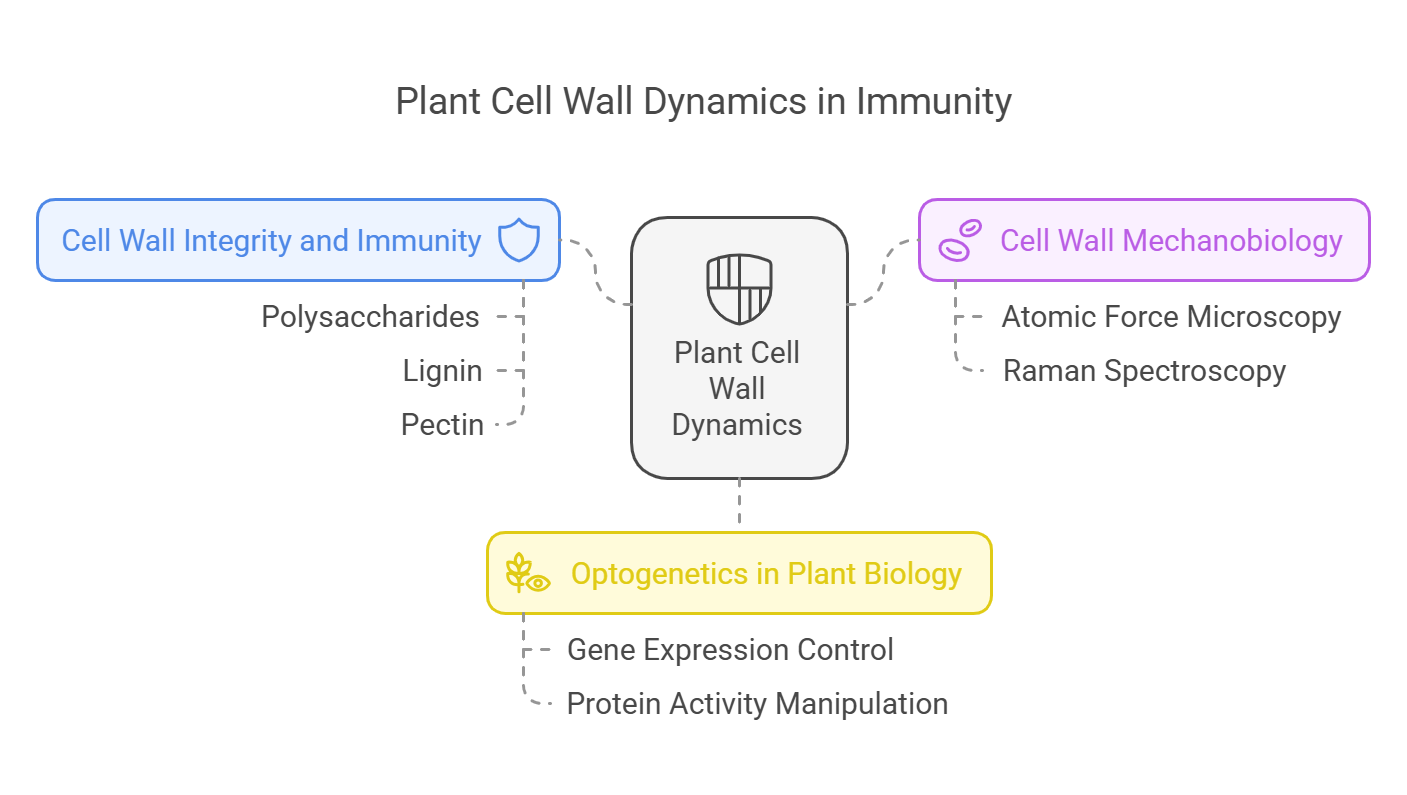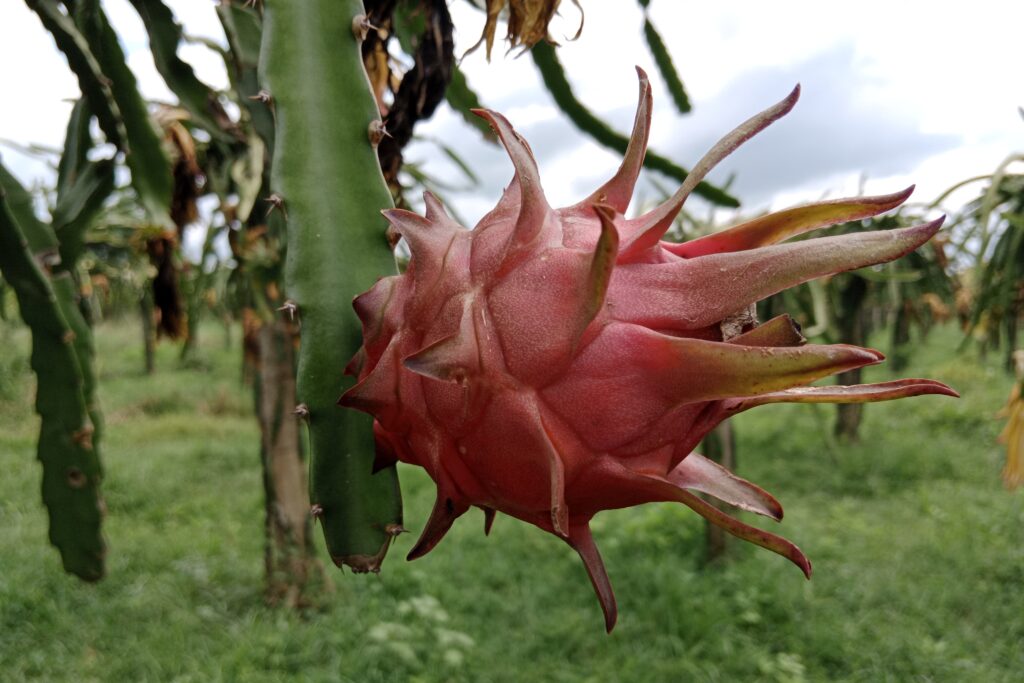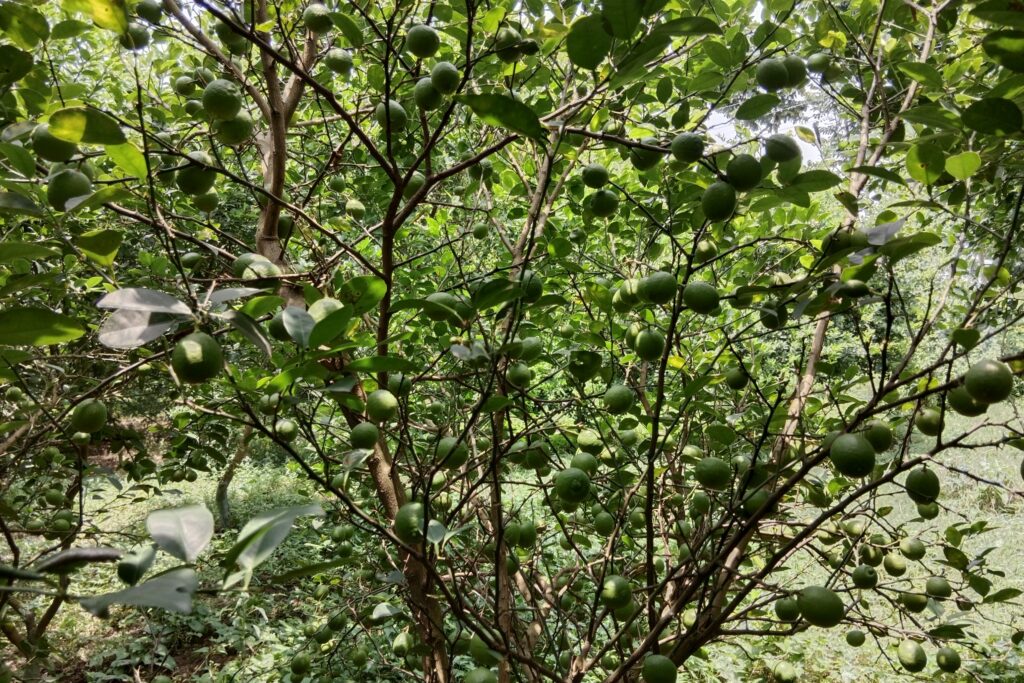Introduction
Plant cell walls are not simply rigid structures that provide shape and support; they are dynamic structures, and their cell wall dynamics serve as multifaceted interfaces playing a crucial role in plant defense (Somerville et al., 2004). Beyond their structural function, cell walls actively participate in sensing and responding to environmental challenges, including pathogen attacks (Hamann, 2015). Recent research has shed light on their ability to act as sensors and regulators during the initial stages of immune responses, particularly through the monitoring of cell wall integrity (CWI) (Vaahtera et al., 2019). This process involves detecting changes in cell wall composition and mechanics caused by biotic or abiotic stress and translating these changes into defense signals.
Understanding the intricate connections between cell wall properties—such as mechanics, biochemical composition, and molecular organization—and plant defense signaling pathways is essential for elucidating the mechanisms that underpin plant-pathogen interactions (Bacete et al., 2018). Such knowledge not only advances our fundamental understanding of plant immunity but also opens avenues for developing crops with enhanced resilience to diseases (Le Gall et al., 2015). This study aims to explore these links in greater depth, focusing on the role of cell walls as both a barrier and a communicator in the plant’s defensive arsenal.
Literature Review
The plant cell wall serves as the primary defense barrier against pathogens, and its structural properties and biochemical composition play a pivotal role in pathogen recognition and the activation of immune responses. Several studies have highlighted key aspects of cell wall dynamics in plant immunity:

Cell Wall Integrity and Immunity
Maintaining cell wall integrity (CWI) is critical for plant defense. Alterations in cell wall components, such as polysaccharides, lignin, and pectin, are known to influence pattern-triggered immunity (PTI) (Hamann, 2015). For instance, changes in the deposition of lignin—a phenolic polymer that reinforces the cell wall—and modifications to pectin can enhance the plant’s ability to resist pathogen invasion. Research by Hamann (2015) emphasizes the importance of these modifications as signals that activate defense pathways, thereby linking cell wall remodeling with immune responses.
Cell Wall Mechanobiology
Recent advances in analytical techniques, such as atomic force microscopy (AFM) and Raman spectroscopy, have provided new insights into how mechanical stresses and changes in cell wall composition influence plant defense. Some studies demonstrated that mechanical alterations in the cell wall, induced by pathogen attack or environmental stress, can trigger defense signaling pathways. These techniques have opened new avenues for studying the biophysical aspects of cell walls in the context of plant-pathogen interactions (Wolf, 2022).
Optogenetics in Plant Biology
Although optogenetics has been extensively applied in neuroscience to manipulate biological processes using light, its adoption in plant biology is still in its early stages. Recent innovations indicate the potential of optogenetic tools for achieving precise spatiotemporal control of processes such as gene expression, protein activity, and signaling pathways in plants (Christie et al. (2021). This approach offers exciting opportunities to dissect complex plant defense mechanisms with unprecedented precision.
Research Gap
Significant advancements have been made in uncovering the molecular components involved in cell wall integrity (CWI) monitoring and pattern-triggered immunity (PTI). However, several critical gaps in our understanding remain, particularly regarding the dynamic interactions between cell wall properties and plant immune signaling. These gaps include:
Real-Time Translation of Cell Wall Changes to Immune Signaling Events
While the role of cell wall composition and mechanics in plant defense is well-recognized, how real-time alterations in these properties are sensed and transduced into specific immune signaling events remains poorly understood. The temporal and spatial dynamics of these processes are essential for understanding how plants rapidly respond to pathogen attacks.
Role of Specific Cell Wall-Degrading Enzymes in Defense Modulation
Cell wall-degrading enzymes, often secreted by both plants and pathogens, play dual roles. While pathogens utilize these enzymes to breach the cell wall barrier, plants can recognize the enzymatic activity or its byproducts as danger signals, activating defense responses. The precise functions of individual enzymes and their contributions to modulating immune pathways have not been fully elucidated, creating a significant knowledge gap.
Correlations Between Nanoscale and Macroscale Cell Wall Perturbations and Plant-Pathogen Dynamics
The relationship between localized (nanoscale) cell wall perturbations and broader (macroscale) plant-pathogen interaction dynamics remains unclear. Bridging this gap is crucial for a comprehensive understanding of how structural and mechanical changes in the cell wall influence the overall outcome of pathogen interactions.
This research aims to address these gaps by integrating advanced methodologies, including:
- High-Resolution Imaging Techniques: Employing tools such as atomic force microscopy (AFM), Raman spectroscopy, and confocal microscopy to visualize and quantify cell wall changes at nanoscale resolution during pathogen interactions.
- Synthetic Biology Tools: Using innovative synthetic biology approaches to manipulate specific cell wall components and signaling pathways with precise spatial and temporal control. These tools will help establish causal relationships between cell wall modifications and immune responses.
- Interdisciplinary Analysis: Combining biophysical, biochemical, and molecular approaches to link cell wall perturbations to downstream defense mechanisms, from nanoscale changes to whole-plant responses.
Also Read About: Plant Cell Wall
Hypothesis
Changes in cell wall mechanics and composition act as primary triggers for immune signaling cascades in plants, and precise modulation of these changes can influence the strength and nature of immune responses.
Objectives
- To monitor real-time changes in cell wall mechanics and composition in response to diverse immune elicitors using Brillouin-Raman microscopy.
- To develop a chemo-optogenetic toolkit for precise control of cell wall-degrading enzymes, enabling simulation of targeted cell wall perturbations.
- To investigate the impact of specific cell wall perturbations on signaling pathways through transcriptomic, proteomic, and metabolomic analyses.
- To establish correlations between nanoscale cell wall changes and macroscale plant-pathogen interactions.
Materials and Methods
Brillouin-Raman Microscopy
This advanced microscopy technique will be utilized to monitor real-time, in vivo changes in cell wall properties during pathogen challenges.
- Purpose: The combination of Brillouin and Raman microscopy allows simultaneous measurement of mechanical properties (via Brillouin scattering) and chemical composition (via Raman spectroscopy) of the cell wall.
- Application: Immune elicitors such as flagellin and chitin, known to trigger plant defense responses, will be applied to plants. The resulting cell wall dynamics, such as alterations in stiffness and compositional changes, will be visualized to understand how the wall responds to immune signals.
Development of Chemo-Optogenetic Toolkit
To achieve precise control over cell wall-modifying enzymes, a chemo-optogenetic system will be developed.
- Engineering Constructs: Light-responsive optogenetic constructs will be designed for enzymes such as pectinase and cellulase, which are involved in cell wall modification.
- Control Mechanism: These constructs will allow spatial and temporal control of enzyme activity using light as a trigger, enabling the study of localized cell wall degradation and its impact on defense responses.
- Significance: This approach ensures controlled experiments to dissect the role of specific enzymes without introducing unintended variability.
Multi-Omics Approaches
To comprehensively analyze the molecular changes associated with cell wall perturbations, a suite of omics tools will be employed:
- Transcriptomics: RNA sequencing will be used to identify genes that are differentially expressed in response to changes in cell wall integrity, providing insights into the genetic regulation of defense pathways.
- Proteomics: Mass spectrometry will analyze changes in protein abundance and post-translational modifications, revealing how proteins involved in defense are regulated.
- Metabolomics: Profiling of secondary metabolites, such as phenolics and phytoalexins, will link cell wall dynamics to biochemical defense outputs, offering a holistic view of the plant’s metabolic response.
Plant-Pathogen Interaction Studies
To understand how cell wall dynamics influence pathogen resistance, interaction assays will be conducted with model pathogens:
- Pathogen Models: The bacterial pathogen Pseudomonas syringae and the fungal pathogen Botrytis cinerea will be used to simulate diverse infection scenarios.
- Correlation Studies: Nanoscale imaging data from Brillouin-Raman microscopy will be integrated with observed disease resistance phenotypes, bridging the gap between molecular-scale changes and macroscopic outcomes such as lesion size or pathogen load.
Statistical Analysis
A rigorous statistical framework will be employed to validate findings and derive meaningful insights from complex datasets:
- Data Integration: Multivariate analyses will combine imaging data with omics results to uncover patterns and correlations.
- Hypothesis Testing: Statistical tests will be performed to confirm causal links between cell wall dynamics and immune responses, ensuring the robustness and reproducibility of the results.
Expected Outcomes
Insights into Cell Wall Dynamics
- Real-Time Visualization: The use of Brillouin-Raman microscopy is anticipated to provide unprecedented real-time data on how plant cell walls dynamically respond to immune elicitors, such as flagellin and chitin. These insights will reveal specific changes in mechanical properties (e.g., stiffness, elasticity) and chemical composition during the early stages of plant defense.
- Key Features in PTI: The research aims to identify critical mechanical and compositional characteristics of the cell wall that are directly linked to pattern-triggered immunity (PTI), enhancing our understanding of how plants detect and respond to pathogenic threats.
Innovative Tools for Plant Biology
- Chemo-Optogenetic Toolkit: The development of a light-activated chemo-optogenetic system for precise spatial and temporal manipulation of cell wall-degrading enzymes (e.g., pectinase, cellulase) is expected to be a significant innovation. This toolkit will allow researchers to study localized cell wall modifications and their impact on immune responses with unparalleled control.
- Utility Demonstration: By applying this toolkit to investigate plant immunity, the research will not only validate its effectiveness but also showcase its potential for broader applications in plant biology and beyond.
Mechanistic Understanding of Plant Defense
- Signaling Pathways: The project aims to elucidate the molecular signaling pathways that are activated in response to cell wall perturbations, shedding light on how changes in cell wall integrity translate into immune signaling events.
- Multi-Scale Integration: By correlating nanoscale cell wall dynamics observed through imaging with whole-plant immune responses (e.g., pathogen resistance phenotypes), the study will provide a comprehensive understanding of plant defense mechanisms from the molecular to the organismal level.
Broader Applications
- Crop Improvement: The findings have the potential to inform strategies for improving crop resistance to pathogens by targeting cell wall-associated immune mechanisms. This could lead to the development of more resilient crop varieties.
- Advancing Plant Biophysics and Synthetic Biology: The novel methodologies established in this study, including the chemo-optogenetic toolkit and advanced imaging approaches, could set a new standard for research in plant biophysics and synthetic biology. These tools and techniques may inspire future investigations into plant structure-function relationships and innovative biotechnological applications.
Conclusion
This finding will advance our understanding of the pivotal role of cell wall dynamics in plant immunity, leveraging cutting-edge microscopy and synthetic biology approaches. By linking nanoscale changes to macroscale outcomes, the findings will contribute to fundamental plant science and have translational potential for sustainable agriculture.
References
- Bacete, L., Mélida, H., Miedes, E., & Molina, A. (2018). Plant cell wall-mediated immunity: Cell wall changes trigger disease resistance responses. The Plant Journal, 93(4), 614–636.
- Christie, J. M., and Zubriggen, M.D. (2021). Optogenetics in plants: a new tool for plant research and crop improvement. New phytologist, 26(2), 115-129.
- Hamann, T. (2015). The plant cell wall integrity maintenance mechanism—A case study of a cell wall plasma membrane signaling network. Phytochemistry, 112, 100–109.
- Le Gall et al. (2015). Cell wall metabolism in response to abiotic stress. Plants, 4(1), 112–166.
- Somerville et al. (2004). Toward a systems approach to understanding plant cell walls. Science, 306(5705), 2206–2211.
- Vaahtera, L., Schulz, J., & Hamann, T. (2019). Cell wall integrity maintenance during plant development and interaction with the environment. Nature Plants, 5(9), 924–932.
- Wolf, S. (2022). Cell Wall Signaling in Plant Development and Defense. Annual Review of Plant Biology, 73, 323-353.


